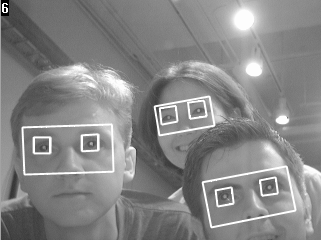



Eye detection and tracking is integral for attentive user interfaces. Towards this end, we are working on a low cost, reliable eye tracker. We also use eyes to extract higher level features such as faces and blink rates. We are currently working on interfaces that use this high level information to more effectively support the interaction.
 |
Using a black and white camera with structured infrared lighting (courtesy of IBM Research), we can realiably detect and track eyes. |
| Finding a good threshold for different environments is hard. Picking a bad threshold yields too many false positives. |

|
| We use the physiological properties of eyes, their appearance and dynamics to detect and track eyes reliably. Only regions that reflect light back, look like, and move like eyes are tracked. |

|
| We are currently working on extracting higher level features. At the moment, we are able to reliably find faces for multiple people and compute blink statistics. We are interested in using these features to help us do face recognition, head pose estimation, and to measure attention/sleepiness. |

|
Results of our eye tracker can be found here (pupil.mpg, 352x240, ~10mb).
"Detecting and Tracking Eyes By Using Their Physiological Properties, Dynamics, and Appearance",
A. Haro, M. Flickner, and I. Essa,
Proceedings IEEE CVPR 2000, Hilton Head Island, South Carolina, June 2000.
(Abstract | PS.Z | PDF ).
Also available as Georgia Tech, GVU Center Tech Report No. GIT-GVU-TR-99-46
(Abstract | PS.Z | PDF ).
"A Non-Invasive Computer Vision System For Reliable Eye Tracking",
A. Haro, I. Essa, and M. Flickner,
Proceedings ACM SIGCHI 2000 (Short Talks and Interactive Posters), The Hague, Netherlands, April 2000.
(Abstract | PS.Z | PDF ).
|
|
|
|
|
|
|
CPL Swiki |
|